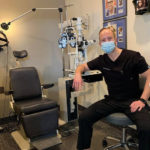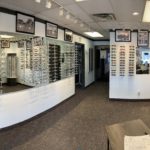 By Solomon Gould, OD, MBA
By Solomon Gould, OD, MBA
August 11, 2021
Millennial and Generation Z patients have different expectations from your older patients. Here are the most important ways I created a practice that is growing in the number of younger patients added.
These improvements have proven beneficial for both patients and the two private practices I own, which are seeing financial gains since the changes highlighted below were implemented. My monthly revenue has increased from baseline, and has consistently wavered between 15 and 25 percent from baseline. My overall return on investment has consistently wavered between 10 and 12 percent. My new patient ratio increased from 40 percent at baseline to a consistent month-to-month range of 45-55 percent. My patient satisfaction scores have increased, and my Google Reviews have gotten better.
The impressive results I generated by proactively meeting the needs of my youngest adult patients is not surprising given that Generation Z is the world’s largest living generation1. The second largest is Millennials. Gen Z outnumbers Millennials by roughly 1 million people. Thus, if you want to build and sustain a successful 21st century practice, understanding and meeting the needs of these two generations is a must.
Social Media Posts Tailored Specifically to Millennials & Generation Z
Some of my practice’s social media posts are created specifically with Millennials in mind while others are targeted toward attracting Gen Z’ers. For Millennials, I emphasize frame lines I brought into my practice from which a percentage of profits goes toward social causes that we support locally. I also utilize discounted promotional campaigns. Research shows Millennials are 50 percent more likely to purchase from a practice that supports a cause2. And two-thirds of Millennials report they will switch brands if they are offered a discount of 30 percent or more2.
For Gen Z’ers, intermixed between promotional marketing, I include authentic, “behind the scenes” type of posts that show my staff and I at work. I also highlight frame lines we brought into our optical that are made of environmentally sustainable materials. Seventy-seven percent of Gen Z’ers prefer social media ads that show real people in real situations over idealistic posts3 and 54 percent of Millennials report that they look for products that are environmentally sustainable3.
Use of Telemedicine & Addition of Wellness Screening Technologies
Both Millennials and Gen Z’ers place substantial value on control and convenience in how they access healthcare. Telemedicine, therefore, fits nicely into most younger people’s perspectives. However, Millennials and Gen Z’ers have different viewpoints on telemedicine and its role in healthcare.
Forty-five percent of Millennials currently report that they don’t have a family practice doctor2. Sixty percent of Millennials express a great deal of interest in telemedicine2. And of those Millennials who have used telemedicine, 75 percent rated it as superior to a traditional on-site office visit2. Gen Z’ers do not place as much value on the telemedicine route. However, they do like to have it as an option nonetheless.
In addition to the ability to receive care via telemedicine, younger generations are showing greater demand for health-preserving products, treatments and lifestyle modifications than their generational predecessors3. They prioritize a preventative, wellness approach to their health and well-being, as opposed to a reactive approach.
Watching this trend tick upwards over the past several years, I implemented two key technologies: the Cognivue Thrive cognitive screening device and the Pharmanex BioPhonotic Scanner, which measures carotenoid levels in living tissue, providing an immediate indication of a person’s overall antioxidant levels. I implemented both of these technologies in my practice in 2020.
I had practiced almost an entire decade focusing almost exclusively on my patients’ eyes. I now treat every patient holistically and take every measure to help my patients in a preventative, wellness-minded manner. These technologies have helped me achieve this on a daily basis. This has been an absolute game-changer for my patients, and my practice has benefited in the process.
The telemedicine software I utilize is an upgraded version of a free software called Doxy.me. which offers month-to-month service without a contract and costs us $35 per month. The Cognivue Thrive cognitive screening device costs us $380 per month, and is also month-to-month service without a contract. The Pharmanex Biophotonic scanner required an initial upfront $3,500 investment.We have already not only broken even on these investments, but profited.

The optical in one of Dr. Gould’s offices. Dr. Gould says he is mindful of both the online and in-office shopping experience of his patients.
Making It As Easy to Shop Online as In-Person
Millennials are split into two groups: the ‘Mega-lennials’ (those currently aged 32 to 37) and the ‘Me-lennials’ (those currently aged 27 to 31).
Forty-three percent of Mega-lennials prefer in-store shopping and 57 percent prefer shopping online. Of the Me-lennials, on the other hand, 38 percent prefer in-store shopping and 62 percent prefer online2. By ensuring I have the right frames, and with the online visibility, I am able to attract both groups of Millennials.
We have a two-way messaging system that is part of our customer relationship management software, Innexus, which allows us to communicate in real time via text with our patients. This gives both Millennials and Gen Z’ers that sense of control and convenience they value. We utilize this feature for everything from announcing a new frame line to notifications of eyeglass jobs being ready for pick up. It also comes in handy for when patients have questions they need to ask your office.
For Gen Z’ers, providing an exquisite experience from their first “touch” of the practice to, (hopefully) check-out with the receptionist and/or optician and deliberate selection of frame inventory, have been the two most successful optical improvements I made.
Other Articles to Explore
Millennials and Gen Z’ers don’t have exactly the same perspective in preference for online versus brick-and-mortar shopping. Eighty-two percent of Gen Z’ers prefer to shop in stores3. More than half (51 percent) of Gen Z’ers report that shopping in stores allows them to ‘disconnect from social media and the digital world3. Seventy-three percent of Gen Z’ers report that they like the “discovery” aspect of brick-and-mortar shopping.
It isn’t enough to provide an exceptional retail experience for Gen Z’ers, who are the most frugal demographic. That means they prefer to shop in your optical, and, hopefully, purchase. However, they will have already shopped your competition, so the price must be right.
References
1 Statista. (2019). Resident Population in the United States in 2019, by generation. https://www.statista.com/statistics/797321/us-population-by-generation/
2 Melton, J. (2019). Digital 360 Commerce. https://www.digitalcommerce360.com/2019/03/26/millennials-online-shopping/
3 Kaplen, M. (2019). Practical E-Commerce. https://www.practicalecommerce.com/generation-z-is-the-most-coveted-retail-demographic
 Solomon Gould, OD, MBA, is the owner of two private practices in the Minneapolis/St. Paul area of Minnesota, as well as a practice management consultant. To contact him: drgould2020@gmail.com
Solomon Gould, OD, MBA, is the owner of two private practices in the Minneapolis/St. Paul area of Minnesota, as well as a practice management consultant. To contact him: drgould2020@gmail.com

























